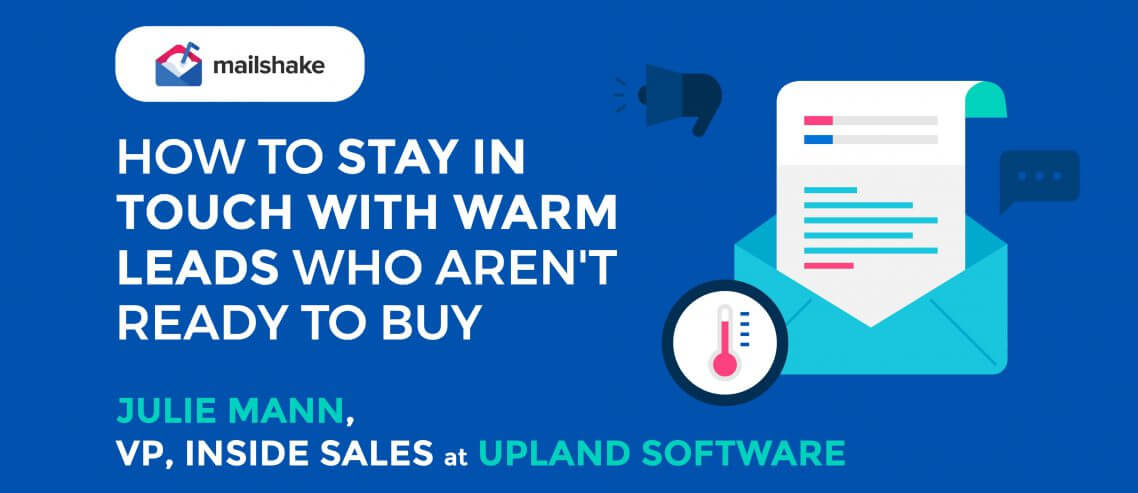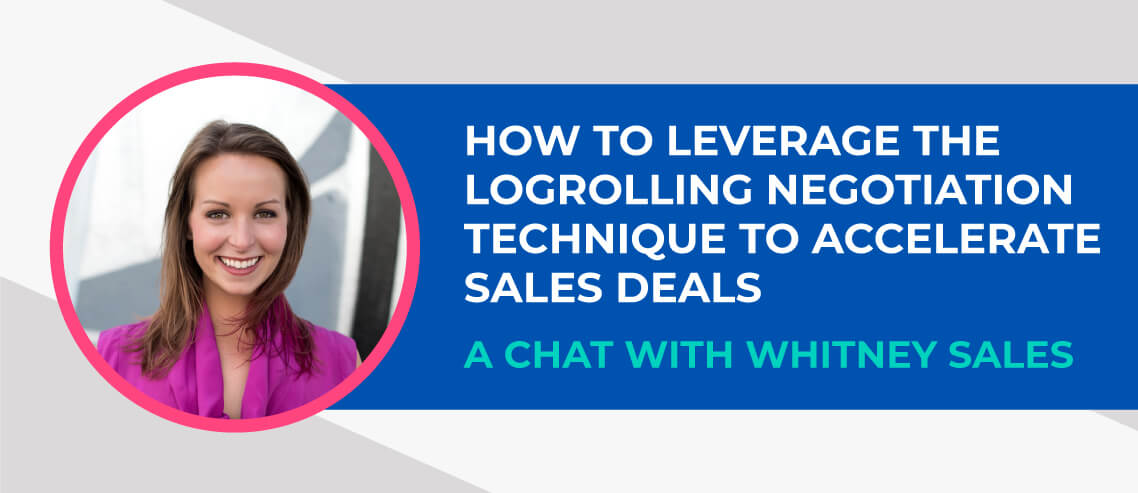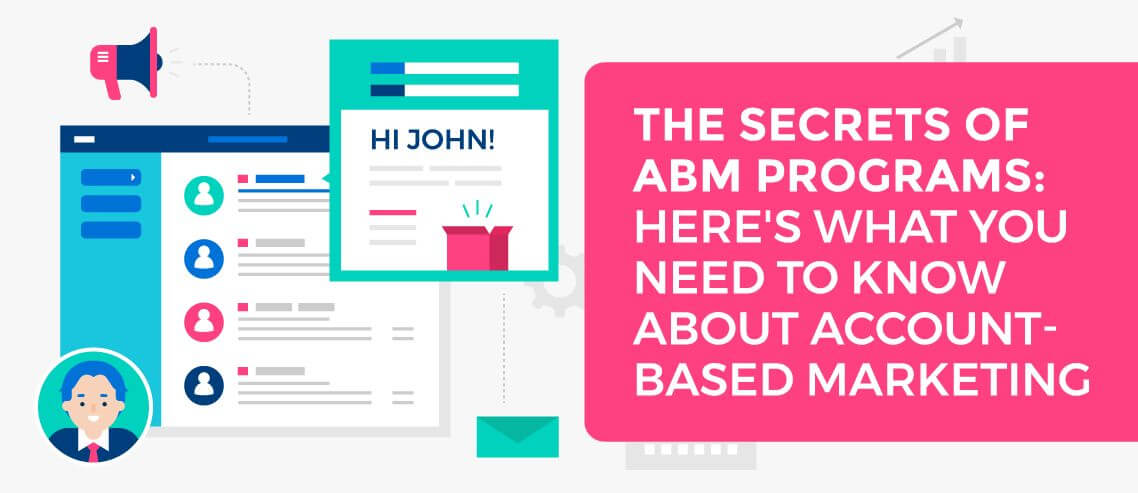How to Stay in Touch With Warm Leads Who Aren’t Ready to Buy

Contents
In a perfect world, every lead would instantly sign on the dotted line.
But just because a lead doesn’t immediately snap up the deal you’re offering doesn’t mean they’re not qualified, or that you shouldn’t continue nurturing them.
I sat down with Julie Mann, Vice President, Inside Sales at Upland Software, to discuss how sales reps can get the contact balance right with warm leads who just aren’t ready to buy yet.
Julie has been a sales practitioner for the past 12 years, including stints at Upland, Optimizely, Spreadfast, and she believes nurture is a seriously undervalued – and often deprioritized – skill in sales.
[lyte id=”hb1pRmEbj4Q” /]
How Do You See Inside Reps Splitting Their Time Between New Prospects and Nurturing Existing Ones? [1:22]
In a typical organization, Julie underlines, around 20% of sales rep time is spent following up new inbound opportunities and new leads, while roughly 65% is dedicated to outbound tasks like prospecting, sourcing and executing.
Just 15% of their time will be spent on two-way engagement with interested people, she estimates.
Julie believes this approach needs to be switched up.
“People spend a lot of time focusing on the people that are coming through as hand raisers, and their goal is to get them quickly to that qualified opportunity stage and through the sales cycle,” she says.
“But what really should happen in an ideal world, is that 60% of your time as an SDR Inside Sales rep should be following up on inbound leads and nurturing leads that you’ve had two-way engagements with. And then the other 40% can be focused more on outbound initiatives.”
What’s the Goal of a Nurture Campaign? [3:34]
Julie says nurture campaigns have two simple goals:
- Identifying the right group of buyers and prospects from your ideal customer profile
- Getting them to buy
“Just being able to isolate those needles from the haystack,” she says of the first goal.
“I had a mentor who used to say: ‘we spend so much time finding the needle in the haystack, and then once it’s in the sales cycle, it falls out somewhere. Then we just go back to trying to find new needles instead of collecting this isolated pile of needles that we can come back to.’”
She explains that nurturing has myriad benefits, including gleaning competitive information from prospects, and collecting ideas on how to improve tools, products, and services.
On her second point, Julie warns sales reps to tread carefully.
“What you don’t wanna do is take these people who you had a great meaningful conversation with and just shove blanket messaging down their throat,” she explains. “Instead, identify them, put them into a fuel line that you can revisit at a very specific cadence, and only be delivering value added material that helps them in their job today.”
How Do You Define Value? [5:09]
“If you have an asset that you can offer somebody, that gives them some benchmark or some information that aligns with the problem they’re trying to solve today – that adds value,” Julie says.
“If it’s inviting them to some kind of a webinar event that really, genuinely pertains to the problem they’re trying to solve – that’s value.”
So what is value not?
“Value is not ‘hey can I get ten minutes on your calendar,’ value is not ‘hey give me information and it’s a one sided relationship.’”
Instead, value is delivering assets that genuinely relate to the conversation you had with the lead, she notes.
So if you’re going to send a prospect a content piece, always consider whether it’s relevant.
How Do You Find the Right Balance for Nurturing? [6:45]
“There is a cadence you can execute that will pretty much make sense for the type of nurture you’re running,” Julie explains.
There are three different types of nurture:
1. Closed loss nurture
This is where there was once a qualified opportunity that fell out of the sales cycle.
“At some point we want to revisit that,” Julie underscores.
“There’s a 3-, 6-, 9-, and 12-month message that these people can receive,” she says. “You can establish a connection with them: “hey I’m gonna stay close to you, not because I’m trying to sell to you, but if I see something that’s valuable to you, now I know a little more about your business, I’m gonna send it your way.””
She explains that once you start sending these messages, you can continue to iterate on them – but you need to be careful you’re not wasting time.
“As you go through the year, the messages become a little more dire and a little more needy perhaps, because “hey, you’ve been with this vendor for 9 months, I want to know if it’s working well or if its not – is there something I can do?””
2. The almost opportunity
“Most of the criteria was met, you are talking to the right person,” Julie says, of the almost opportunity. “They do have the authority. There’s a need there. But timing or budget may be off right now.”
Sales reps should keep these people close through thought leadership, she advises.
“Build a relationship where they see you as the expert and advising. And that cadence can be a little bit more free – it doesn’t just have to be the 3, 6, 9, 12.”
3. Focusing on people who were hand raisers
These are the leads you’re yet to have a meaningful conversation with – but you want to.
They may have downloaded your ebooks, attended your webinars, filled in your forms, or put in a demo request.
“How do you send them information? You do it in a more frequent cadence, but still tailored to their vertical, their persona, and the pain points you’ve seen others have,” Julie says.
How Do You Know When a Warm Lead Is Ready to Buy? [9:35]
Onto the million dollar question.
“The only way to really know and know for sure is to see a spike in activity,” Julie says. “Tons of activity coming through on your website. If you have predictive analytics tools like Sixth Sense, that’s a great way of knowing.”
Sometimes you “just don’t know,” however, she acknowledges. So it’s super important to make sure you’re always on top of that thought leadership, and therefore adding value as an expert.
Chipping away through regular, valuable contact can see a big pay out in the right circumstances – even if early signs are negative, Julie explains.
“Every once in a while you won’t see that activity, and somebody just happens to be reconsidering something.
“Because you have made it easy for them to communicate with you, you’ve been respectful of their time, and you’ve been such a value-added resource along the way, they will come circle back, even if you’re not in their first or second choice.”
Check out Upland Software to browse smart digital tools that could help your team, or find Julie on LinkedIn – she’s always open to connecting, talking about strategies and tips, and learning in a mutual way.





